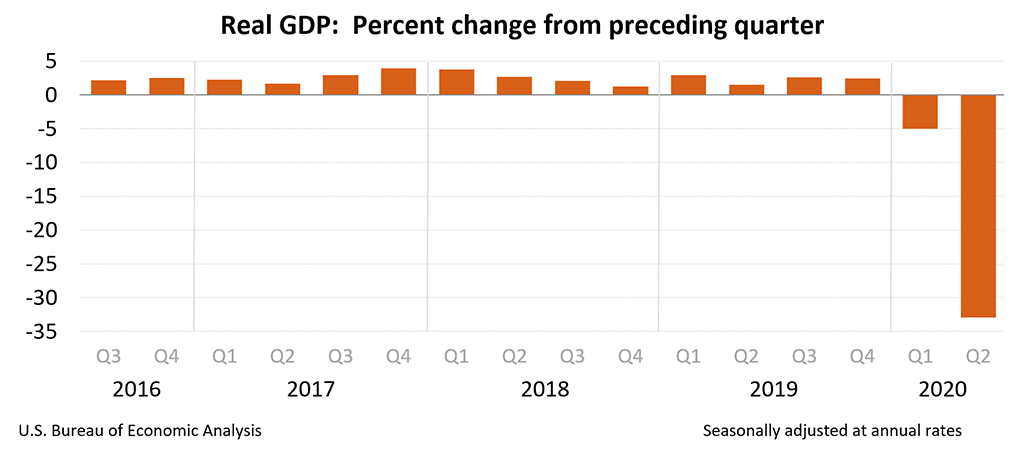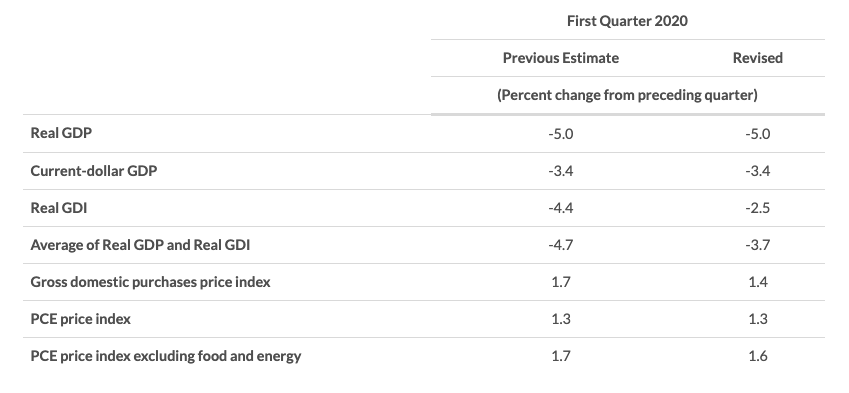Real gross domestic product (GDP) decreased at an annual rate of 32.9% in the second quarter of 2020, according to the "advance" estimate released by the Bureau of Economic Analysis. In the first quarter, real GDP decreased 5%.
The GDP estimate released today is based on source data that are incomplete or subject to further revision by the source agency. The "second" estimate for the second quarter, based on more complete data, will be released on August 27, 2020.

The decline in second quarter GDP reflected the response to COVID-19, as "stay-at-home" orders issued in March and April were partially lifted in some areas of the country in May and June, and government pandemic assistance payments were distributed to households and businesses. This led to rapid shifts in activity, as businesses and schools continued remote work and consumers and businesses canceled, restricted, or redirected their spending. The full economic effects of the COVID-19 pandemic cannot be quantified in the GDP estimate for the second quarter of 2020 because the impacts are generally embedded in source data and cannot be separately identified. For more information, see the Technical Note.
The decrease in real GDP reflected decreases in personal consumption expenditures (PCE), exports, private inventory investment, nonresidential fixed investment, residential fixed investment and state and local government spending that were partly offset by an increase in federal government spending. Imports, which are a subtraction in the calculation of GDP, decreased.
The decrease in PCE reflected decreases in services (led by health care) and goods (led by clothing and footwear). The decrease in exports primarily reflected a decrease in goods (led by capital goods). The decrease in private inventory investment primarily reflected a decrease in retail (led by motor vehicle dealers). The decrease in nonresidential fixed investment primarily reflected a decrease in equipment (led by transportation equipment), while the decrease in residential investment primarily reflected a decrease in new single-family housing.
Current‑dollar GDP decreased 34.3%, or $2.15 trillion, in the second quarter to a level of $19.41 trillion. In the first quarter, GDP decreased 3.4%, or $186.3 billion.
The price index for gross domestic purchases decreased 1.5% in the second quarter, in contrast to an increase of 1.4% in the first quarter. The PCE price index decreased 1.9%, in contrast to an increase of 1.3%. Excluding food and energy prices, the PCE price index decreased 1.1%, in contrast to an increase of 1.6%.
Updates for the First Quarter of 2020
For the first quarter of 2020, real GDP is estimated to have decreased 5%, the same decrease as previously published. An upward revision to private inventory investment was offset by a downward revision to exports and an upward revision to imports.
Real GDI is now estimated to have decreased 2.5% in the first quarter; in the previously published estimates, first-quarter GDI was estimated to have decreased 4.4%. The leading contributor to the upward revision was compensation, based primarily on new first-quarter wage and salary estimates from the BLS Quarterly Census of Employment and Wages.
The price index for gross domestic purchases is now estimated to have increased 1.4% in the first quarter, 0.3 percentage point lower than previously published. The PCE price index increased 1.3%, the same increase as previously published. Excluding food and energy prices, the PCE price index increased 1.6%, 0.1 percentage point lower than previously published.




![[Technology Corner] Quantifying the Impact of a Precision Ag Pioneer](https://www.agequipmentintelligence.com/ext/resources/2024/08/23/Quantifying-the-Impact-of-a-Precision-Ag-Pioneer.png?height=290&t=1724422794&width=400)
Post a comment
Report Abusive Comment